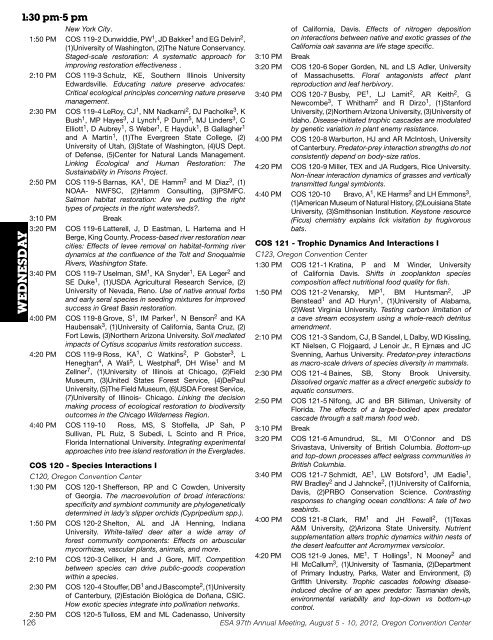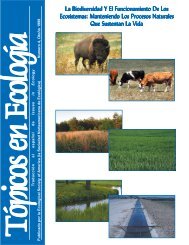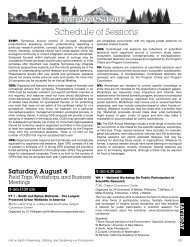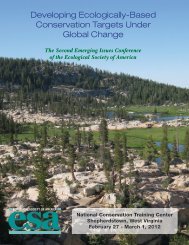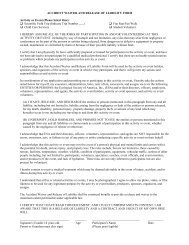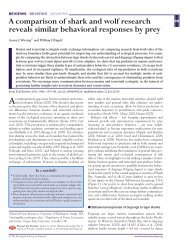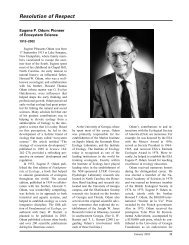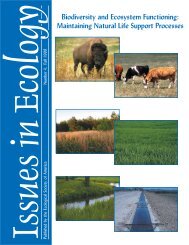Printed Program (PDF) - Ecological Society of America
Printed Program (PDF) - Ecological Society of America
Printed Program (PDF) - Ecological Society of America
Create successful ePaper yourself
Turn your PDF publications into a flip-book with our unique Google optimized e-Paper software.
WEDNESDAY<br />
1:30 pm-5 pm<br />
1:50 PM<br />
New York City.<br />
COS 119-2 Dunwiddie, PW1 , JD Bakker1 and EG Delvin2 ,<br />
(1)University <strong>of</strong> Washington, (2)The Nature Conservancy.<br />
Staged-scale restoration: A systematic approach for<br />
improving restoration effectiveness .<br />
2:10 PM COS 119-3 Schulz, KE, Southern Illinois University<br />
Edwardsville. Educating nature preserve advocates:<br />
Critical ecological principles concerning nature preserve<br />
management.<br />
2:30 PM COS 119-4 LeRoy, CJ1 , NM Nadkarni2 , DJ Pacholke3 , K<br />
Bush1 , MP Hayes3 , J Lynch4 , P Dunn5 , MJ Linders3 , C<br />
Elliott1 , D Aubrey1 , S Weber1 , E Hayduk1 , B Gallagher1 and A Martin1 , (1)The Evergreen State College, (2)<br />
University <strong>of</strong> Utah, (3)State <strong>of</strong> Washington, (4)US Dept.<br />
<strong>of</strong> Defense, (5)Center for Natural Lands Management.<br />
Linking <strong>Ecological</strong> and Human Restoration: The<br />
2:50 PM<br />
Sustainability in Prisons Project.<br />
COS 119-5 Barnas, KA1 , DE Hamm2 and M Diaz3 , (1)<br />
NOAA- NWFSC, (2)Hamm Consulting, (3)PSMFC.<br />
Salmon habitat restoration: Are we putting the right<br />
types <strong>of</strong> projects in the right watersheds?.<br />
3:10 PM Break<br />
3:20 PM COS 119-6 Latterell, J, D Eastman, L Hartema and H<br />
Berge, King County. Process-based river restoration near<br />
cities: Effects <strong>of</strong> levee removal on habitat-forming river<br />
dynamics at the confluence <strong>of</strong> the Tolt and Snoqualmie<br />
Rivers, Washington State.<br />
3:40 PM COS 119-7 Uselman, SM1 , KA Snyder1 , EA Leger2 and<br />
SE Duke1 , (1)USDA Agricultural Research Service, (2)<br />
University <strong>of</strong> Nevada, Reno. Use <strong>of</strong> native annual forbs<br />
and early seral species in seeding mixtures for improved<br />
success in Great Basin restoration.<br />
4:00 PM COS 119-8 Grove, S1 , IM Parker1 , N Benson2 and KA<br />
Haubensak3 , (1)University <strong>of</strong> California, Santa Cruz, (2)<br />
Fort Lewis, (3)Northern Arizona University. Soil mediated<br />
impacts <strong>of</strong> Cytisus scoparius limits restoration success.<br />
4:20 PM COS 119-9 Ross, KA1 , C Watkins2 , P Gobster3 , L<br />
Heneghan4 , A Wali5 , L Westphal6 , DH Wise1 and M<br />
Zellner7 , (1)University <strong>of</strong> Illinois at Chicago, (2)Field<br />
Museum, (3)United States Forest Service, (4)DePaul<br />
University, (5)The Field Museum, (6)USDA Forest Service,<br />
(7)University <strong>of</strong> Illinois- Chicago. Linking the decision<br />
making process <strong>of</strong> ecological restoration to biodiversity<br />
outcomes in the Chicago Wilderness Region.<br />
4:40 PM COS 119-10 Ross, MS, S St<strong>of</strong>fella, JP Sah, P<br />
Sullivan, PL Ruiz, S Subedi, L Scinto and R Price,<br />
Florida International University. Integrating experimental<br />
approaches into tree island restoration in the Everglades.<br />
<strong>of</strong> California, Davis. Effects <strong>of</strong> nitrogen deposition<br />
on interactions between native and exotic grasses <strong>of</strong> the<br />
California oak savanna are life stage specific.<br />
3:10 PM Break<br />
3:20 PM COS 120-6 Soper Gorden, NL and LS Adler, University<br />
<strong>of</strong> Massachusetts. Floral antagonists affect plant<br />
reproduction and leaf herbivory.<br />
3:40 PM COS 120-7 Busby, PE 1 , LJ Lamit 2 , AR Keith 2 , G<br />
Newcombe 3 , T Whitham 2 and R Dirzo 1 , (1)Stanford<br />
University, (2)Northern Arizona University, (3)University <strong>of</strong><br />
Idaho. Disease-initiated trophic cascades are modulated<br />
by genetic variation in plant enemy resistance.<br />
4:00 PM COS 120-8 Warburton, HJ and AR McIntosh, University<br />
<strong>of</strong> Canterbury. Predator-prey interaction strengths do not<br />
consistently depend on body-size ratios.<br />
4:20 PM COS 120-9 Miller, TEX and JA Rudgers, Rice University.<br />
Non-linear interaction dynamics <strong>of</strong> grasses and vertically<br />
transmitted fungal symbionts.<br />
4:40 PM COS 120-10 Bravo, A 1 , KE Harms 2 and LH Emmons 3 ,<br />
(1)<strong>America</strong>n Museum <strong>of</strong> Natural History, (2)Louisiana State<br />
University, (3)Smithsonian Institution. Keystone resource<br />
(Ficus) chemistry explains lick visitation by frugivorous<br />
bats.<br />
COS 120 - Species Interactions I<br />
C120, Oregon Convention Center<br />
1:30 PM COS 120-1 Shefferson, RP and C Cowden, University<br />
<strong>of</strong> Georgia. The macroevolution <strong>of</strong> broad interactions:<br />
specificity and symbiont community are phylogenetically<br />
determined in lady’s slipper orchids (Cypripedium spp.).<br />
1:50 PM COS 120-2 Shelton, AL and JA Henning, Indiana<br />
University. White-tailed deer alter a wide array <strong>of</strong><br />
forest community components: Effects on arbuscular<br />
mycorrhizae, vascular plants, animals, and more.<br />
2:10 PM COS 120-3 Celiker, H and J Gore, MIT. Competition<br />
between species can drive public-goods cooperation<br />
within a species.<br />
2:30 PM COS 120-4 Stouffer, DB<br />
126 ESA 97th Annual Meeting, August 5 - 10, 2012, Oregon Convention Center<br />
1 and J Bascompte2 COS 121 - Trophic Dynamics And Interactions I<br />
C123, Oregon Convention Center<br />
1:30 PM COS 121-1 Kratina, P and M Winder, University<br />
<strong>of</strong> California Davis. Shifts in zooplankton species<br />
composition affect nutritional food quality for fish.<br />
1:50 PM COS 121-2 Venarsky, MP<br />
, (1)University<br />
<strong>of</strong> Canterbury, (2)Estación Biológica de Doñana, CSIC.<br />
How exotic species integrate into pollination networks.<br />
2:50 PM COS 120-5 Tulloss, EM and ML Cadenasso, University<br />
1 , BM Huntsman2 , JP<br />
Benstead1 and AD Huryn1 2:10 PM<br />
, (1)University <strong>of</strong> Alabama,<br />
(2)West Virginia University. Testing carbon limitation <strong>of</strong><br />
a cave stream ecosystem using a whole-reach detritus<br />
amendment.<br />
COS 121-3 Sandom, CJ, B Sandel, L Dalby, WD Kissling,<br />
KT Nielsen, C Flojgaard, J Lenoir Jr., R Ejrnæs and JC<br />
Svenning, Aarhus University. Predator-prey interactions<br />
as macro-scale drivers <strong>of</strong> species diversity in mammals.<br />
2:30 PM COS 121-4 Baines, SB, Stony Brook University.<br />
Dissolved organic matter as a direct energetic subsidy to<br />
aquatic consumers.<br />
2:50 PM COS 121-5 Nifong, JC and BR Silliman, University <strong>of</strong><br />
Florida. The effects <strong>of</strong> a large-bodied apex predator<br />
cascade through a salt marsh food web.<br />
3:10 PM Break<br />
3:20 PM COS 121-6 Amundrud, SL, MI O’Connor and DS<br />
Srivastava, University <strong>of</strong> British Columbia. Bottom-up<br />
and top-down processes affect eelgrass communities in<br />
British Columbia.<br />
3:40 PM COS 121-7 Schmidt, AE1 , LW Botsford1 , JM Eadie1 ,<br />
RW Bradley2 and J Jahncke2 4:00 PM<br />
, (1)University <strong>of</strong> California,<br />
Davis, (2)PRBO Conservation Science. Contrasting<br />
responses to changing ocean conditions: A tale <strong>of</strong> two<br />
seabirds.<br />
COS 121-8 Clark, RM1 and JH Fewell2 4:20 PM<br />
, (1)Texas<br />
A&M University, (2)Arizona State University. Nutrient<br />
supplementation alters trophic dynamics within nests <strong>of</strong><br />
the desert leafcutter ant Acromyrmex versicolor.<br />
COS 121-9 Jones, ME1 , T Hollings1 , N Mooney2 and<br />
HI McCallum3 , (1)University <strong>of</strong> Tasmania, (2)Department<br />
<strong>of</strong> Primary Industry, Parks, Water and Environment, (3)<br />
Griffith University. Trophic cascades following diseaseinduced<br />
decline <strong>of</strong> an apex predator: Tasmanian devils,<br />
environmental variability and top-down vs bottom-up<br />
control.


